David Doherty is a refugee from all things functional or organized. In other words, he is a Peace Corps volunteer serving in Haiti.
Monday, 8 Dec 2003
CAMP PERRIN, Haiti
Haitian proverb: Se pa bon pou yon moun konnen twop.
“It’s not good for a person to know too much.”
Today is the latest critical point in our school construction project. It’s time to compose the final document that may or may not get us the necessary funds to build. Canada, one of Haiti’s best benefactors in that they actually pay for projects instead of funding long-established agencies that provide relief without development, has put our proposal on the fast track. (I think everyone can agree that Canadians are just darn nice people except, possibly, for a few strident Quebecois.) A committee will meet in seven days to decide our immediate fate.
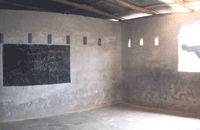
A typical Haitian classroom for 60-80 kids.
Lekol Reforme is a primary school in search of a home. Founded in 1986, it has been a migrant since losing its building in 2000. Despite working under conditions reminiscent of the old inner-city housing commercial from the 1960s (“nothing a 15-cent washer can’t fix”), they have managed to provide an education to 258 students from preschool through grade six. This is testament to the dedication and passion of the founder, Madame Joseph Esther Dumesle. Her inspiration gave me the idea to view the process of building a school from a holistic viewpoint.
Now one might argue that a school has nothing to do with the environment. That could be a debatable point in a developed country, but having lived in rural Haiti since early 2002, I regard educational reform as the key to addressing the near-moribund state of environmental awareness and protection in the underdeveloped world.
Haitians use the old French educational system. By old, I am referring to Napoleonic. The notion that children can learn by rote memorization enforced by liberal use of a baton or martinet (small whip) has remained little changed since independence in 1804. Unfortunately, this fear-based method encourages repetition without comprehension, actively punishes creative thought processes, and suppresses critical thinking.
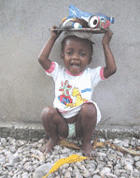
Let’s give this girl a good education.
In a country that has fallen below subsistence level, primal forces limit how far one dares to think into the future. The only focus is on getting enough to eat or pay for the doctor or go to church or put on a funeral. Everything is immediate because hope has diminished to a dim flicker. Ergo, the most sensible thing is to forget the past, never consider the future, and simply try to make it through today.
The result: Cut down all the trees because they can be sold for charcoal today. We can deal with the resulting floods and soil loss caused by deforestation when it’s an immediate problem.
Take away people’s ability to learn from the past or plan for the future and you have Haiti. It’s a land populated with people I love dearly, but one that frustrates beyond all reason. I live in a country where the beneficiaries are incapable of solving their own problems and are relatively content to wait until some outside force intervenes.
I recruited three Americans (architect Eric Davenport, permaculturist Liddy Arens, and arts facilitator Anna Peterson) and an Australian (permaculturist Charlie Knoles) to help design a school that accommodates the needs of education in a facility that draws tangible links between people and their natural environment. After six months of intensive study and design, we think we may have found the equilibrium between the natural elements (light, wind, rain, vegetation) and physical space that will balance the needs of human activity with the need to protect our natural resources.
Maybe we’re being too pie-in-the-sky with our hopes for this project. Maybe not. But if the Canadians pony up the dough next week, I invite any and all readers of this submission to visit Haiti in 20 years and see if we were right or wrong.
Tuesday, 9 Dec 2003
CAMP PERRIN, Haiti
Haitian proverb: Moun grangou pa ka tande.
“A hungry man cannot hear.”
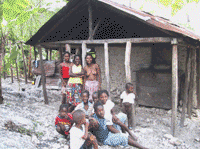
Outside Port-au-Prince, Haitian families average six to nine people.
Haiti is hallowed ground in much the same way as Gettysburg or Flanders Field. The war is over and the carcass of the environment has been buried under a field devoid of arable soil, potable water, or prospects for resurrection. It should be noted that somewhere between 8 million and 12 million people (no one is really certain) are wandering between the headstones trying to eke out a living and very few of them seem ready to take on the caretaker role. Jacques Cousteau described Haiti as a land beyond environmental redemption. The scourge of AIDS threatens to accelerate the fulfillment of his prophecy.
National statistics are so unreliable as to be laughable. The official U.N. AIDS website cites the HIV infection rate among Haiti’s population as 6.5 percent. International service organizations working within Haiti assume the figure is between 13 and 18 percent. Doctors working in the community estimate that as much as 40 percent of the population may be HIV-positive.
One of the oldest and most respected AIDS-related research programs is in Port-au-Prince. The organization can make educated guesses about HIV infection in the capital city, but no one can speculate on a national level because not enough is being done (outside of a few highly publicized efforts — Dr. Paul Farmer, Albert Schweitzer Hospital, etc.) in the provinces where 75 percent of the people live.
Every Peace Corps volunteer has a mandate to work in areas of AIDS education and awareness. In a country where open discussion of sex is taboo, this presents certain challenges. (As the average age for girls to commence sexual activity is 12, it may be that many lack sufficient maturity to have a serious conversation on the topic.) In collaboration with a health volunteer living in nearby Cance — a Paris- and Haiti-educated physician who directs an environmental NGO called ORE, Organization for the Rehabilitation of the Environment — we have started to tackle the problem in our area.
This day has been dedicated to laying the groundwork for doing a school census, establishing a working framework with the local hospital, and obtaining the various and sundry official sanctions that are necessary for anything related to health or education. (In a country having a government with a world-class inability to manage anything, it is usually counterproductive to work within the system. However, the health and education ministries would rather do a bad job than no job at all, so we must deal with them.) As I live in an enlightened part of Haiti, all the parts seemed to work smoothly today.
Now comes the hard part. My Peace Corps counterpart, Jennifer Morley, and I must travel the back roads and cross the occasionally raging Ravine du Sud in order to identify resources within each of the 58 primary and secondary schools in the commune of Camp Perrin. Students must be counted and grouped by grade, gender, and age. (One big problem in Haitian schools is the range of ages within a single class. It is normal to find 19- or 20-year-old males in the fifth grade sitting side-by-side with 12- to 13-year-old girls. This is a high-risk mix of hormonally driven older males with younger girls in search of identity and acceptance.) This is no mean feat as the official unofficial tally for primary school students in the area is nearly 11,000. Secondary schools add another 8,000 to 9,000 young people.
Once we have collected this information and performed the sleight of hand usually reserved for statisticians in the Congressional Budget Office, we will work with an Arlington, Va.-based NGO called Family Health International. Using funding from the U.S. Agency for International Development, they have developed seminars for training HIV/AIDS educators and for implementing comprehensive medical programs that include free HIV testing and intervention for pregnant women (including drugs that can dramatically reduce the incidence of mother-to-child transmission). We hope that in later years, the antiretroviral programs will be extended as well.
I am already over the legal length limit for today’s diary entry, but I felt that a discussion of HIV/AIDS was critical to understanding yet another of the underlying reasons for the decline of what was once the most profitable colony in the world. (Just prior to achieving independence, Haiti accounted for between 30 percent and 50 percent of France’s worldwide GDP!)
As with many sub-Saharan countries, life expectancy is dropping and the number of AIDS orphans is climbing. Coupled with a high birth rate (4.7 live births per woman) and a declining child mortality rate (270 per 1000 10 years ago; 130 per 1000 today, thanks to international efforts), the rising number of AIDS-related deaths has contributed to a situation where nearly half the population is under the age of 14. The already depleted environment cannot possibly keep pace with the increasing population (expected to double by 2027).
Wednesday, 10 Dec 2003
CAMP PERRIN, Haiti
Haitian proverb: Nanpwen maladi li pa gen remed.
“There is no illness that doesn’t have a remedy.”
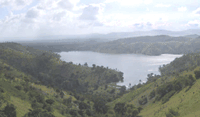
The hills are alive! Not all of Haiti is dead and brown.
I finished eating my breakfast of tuna fish and crackers while chatting with the mechanics at the office of ORE, Organization for the Rehabilitation of the Environment. As I searched for someplace to dispose of the empty tuna can, Anzou directed me to toss it over a nearby fence. It was a not-so-subtle reminder that I’m in Haiti.
ORE is a Haitian NGO that was founded on the premise that farmers will not cut down trees if their value in fruit production exceeds their value for wood products. Starting with funding from the Canadian Embassy in 1986, the three principals of ORE — British professional photographer Sean Finnigan, his Haitian physician wife Mousson, and a U.S.-educated Haitian agronomist Eliassaint Magloire (a relative of Haitian President Paul Magloire, who was forced out of office by “Papa Doc” Duvalier) — introduced top-grafting to Haiti. Coupled with traditional techniques, they brought commercial-grade grafted fruit trees to Haiti.
The Madame Francique mango is now one of the chief sources of income for farmers in the south of Haiti. In addition, out-of-season avocados, mandarin oranges, clementines, carambola (star fruit), and tangelos have created new wealth for farming families. Through later funding from U.S. AID and the European Union, ORE was able to expand their programs to include mini-setting (for plantains, yams, etc.) and hybrid-seed development for staple crops.
As no good deed shall go unpunished, funding dried up just as the various programs were poised to make their greatest impact. In the words of the director of one of Haiti’s largest donors, “The south [of Haiti] is relatively prosperous; we must direct our monies to areas with the greatest need.” On one hand, the logic is incontrovertible: Health and nutrition programs are vital initiatives if one wants to avoid a catastrophic collapse of this country. On the other hand, feeding programs destabilize the local agricultural base (farmers can’t compete with free food), thus decreasing food security. And on the third hand, if one is allowed a bit of tri-dexterity, is it a good idea to walk away from a region just as it is starting to turn the corner?
ORE will cease to function as a viable force to mitigate deforestation and the disappearance of water sources if they do not receive new funding by March of 2004. The Global Environment Fund as administered by the United Nations Development Program may be our last, best chance to secure adequate support to continue the regional trend toward increased tree cover. Spring preservation and expanded tree cultivation are vital components of protecting the future for this part of Haiti.
Thus, Sean and I find ourselves locked away in a secure facility pondering the what-ifs and the why-fors as we write up a funding proposal. More than a mere academic exercise, the goal is to convince the powers that be to invest in a region of Haiti that has the best chance to become productive on a large scale. (In the world of international aid, the word “sustainable” has become verboten as the only thing that has been sustained in most underdeveloped countries is the need to keep pumping in good money after bad.) It’s time to abandon the Band-Aid approach to development.
Thursday, 11 Dec 2003
CAMP PERRIN, Haiti
Haitian proverb: Sak vid pa kanpe.
“An empty sack cannot stand.”
This is a special day. Four Colombian students have arrived for a visit to ORE (Organization for the Rehabilitation of the Environment) and the Camp Perrin region. They are part of a program organized by CiNA (Cimenterie National), the only concrete manufacturer in Haiti.
CiNA had been a state-owned enterprise. As such, it was a major loss leader for the government of Haiti. When the financial drain exceeded the ability of the government to pay, they privatized the firm. A private group headed by another cement company in Colombia purchased it. Its director general is a man of Old World charm who has a genuine concern for those less fortunate. In a country where people take even when there is nothing of seeming value left on the table, Carlos wants to give back. He has allocated 5 percent of operating profits to a fund that will be used to run programs designed to make the community around the CiNA plant in western Haiti a better place to live. Since it’s also good business to keep the locals happy, he enjoys a level of support from the board of directors back in Bogota.
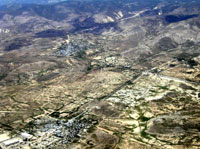
A grim landscape.
ORE has been collaborating with CiNA in doing a complete survey of the agricultural, environmental, and social potential of the land and towns surrounding the CiNA plant. The preliminary findings cast a pall over the potential to create a local economy that is independent of the two industries in the vicinity. Complete deforestation in the surrounding mountains, catastrophic soil erosion, and mismanagement of what little arable land exists (poor farming techniques, free-range grazing for goats, indiscriminate cutting of the few trees that remain to make charcoal) have left little hope for stabilizing the already bad environment, let alone reversing its decline. In addition, the transient natures of the four towns that surround the plant (potential jobs became a magnet for people from every part of the country) work against a sense of common purpose; the traditional Haitian town is based on blood ties and neighborhoods that have been stable for generations.
It was a dramatic contrast for the students when they arrived here. They had left a semi-arid wasteland for another world. Trees, ample water, and cooler temperatures had replaced the dust and heat of their home base. They traded Dante’s inferno for a few days in Eden.
We spent the day driving into the mountains to look at pepinye (tree nurseries) that were being run by local cooperatives. These nurseries had been established under the aegis of ORE but were now functioning independently of outside subsidies. In the town of Navarre, we marveled at a well-organized operation containing 13,000 mango trees and 3,000 mandarin orange trees. Most interesting to me, they were using grenadine as a natural fence to keep goats from entering the nursery and chowing down on some tender vittles. Turns out that goats don’t like grenadine.
As we drove along the very bad roads that characterize much of Haiti, we took time to stop and speak with farmers. They were clear as to the effect of grafted fruit trees in their lives and their environment. As they pointed to hillsides that had been bare 10 years ago but were now filled with producing trees, they gave specifics about the financial impact on their families. One man said school tuition was paid for by late-season avocados and Madame Francique mangos. (When he told me that he had 10 children, I could not help but wonder if a little family planning information could not have maximized the return on investment from his non-human crops.)
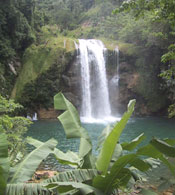
Escape to paradise.
It was a hot day in the mountains. Since we happened to be near one of the greatest natural wonders of the Caribbean, we opted to take a swim at the waterfall in Saut Mathurine. The majesty of this display of the power of water drives one to consider what Haiti must have been like when Columbus first stepped foot on her soil. (Contrary to popular belief, the Nina, Pinta, and Santa Maria made the Haitian side of the island their first port of call. Because the Dominican Republic was faster to erect a monument, tourists have come to believe that Chris “discovered” the right side of Hispaniola first. Shows you what people will believe with a good marketing program.)
Friday, 12 Dec 2003
CAMP PERRIN, Haiti
Haitian proverb: Lavalas pa janm brote sa Bondye sere pou ou.
“The great flood never carries away what God has in store for you.”
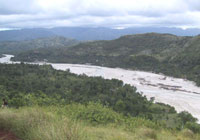
River of screams.
Peace Corps has a color-code system to warn volunteers about impending risk or danger. Certain areas of the country are always considered Code Red. (These are prone to spontaneous acts of political activity or violence and include Cite Soleil, the largest slum in Port-au-Prince, and the city of Gonaives in the Artibonite.) In the case of hurricane or natural disaster, code colors are assigned and transmitted via a human contact tree system.
Last Friday, a Code Yellow alert went out due to the threat of heavy rains from Tropical Storm Odette and all Peace Corps volunteers in her path were put on evacuation notice.
My town, Camp Perrin, is located on the Ravine du Sud. For much of the year, the river flowing through it is sufficiently narrow and calm to ford by foot. However, during heavy storms in the mountains, the character and the demeanor of the river undergoes a Mr. Hyde-like metamorphosis. There is no tree or ground cover to hold or even slow the progression of rainwater down the hillsides and into the ravine. With little notice, the Ravine du Sud becomes a killing ground.
The commercial part of town bears the brunt of raging floodwaters that spill over the gabions paid for with U.S. AID money. Bowling ball-sized rocks and other debris tear through the streets and fill the canal system; they must later be removed using simple hand tools. The main reason flood-control measures have failed to have any effect is a matter of simple physics. In the past 15 years, floods have deposited enough rocks and other material to raise the riverbed a startling eight feet. As a result, the main road and all of the buildings in the Amba-kan (“under camp”) section are now sitting below water level.
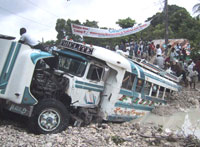
Get off the bus.
The town was a victim of two floods in 2002. In May of that year, 23 people were killed and 379 persons displaced. The September flood was less costly in terms of human life, but many more houses were lost as well as the only footbridge crossing the river. The only solution is to move every resident off the flood plain. (As the U.S. Army Corps of Engineers learned the hard way after 100 years, rivers will go where they want to go.) Unfortunately, the government of Haiti lacks the will or the means to effect this change.
The same team that collaborated on the school design (see Monday’s entry) has been working with a local group of young entrepreneurs called AJEC. Their plan is to relocate the 30 most at-risk families (217 people) to new homes on higher ground. You can read more about that project as well as the floods of 2002 on the ORE website.
I hope some of you found these brief reports from Haiti interesting if not informative. I’ve enjoyed writing about my new home. Given the media coverage of Haiti in the mainstream press, most folks think that this country is a lost cause devoid of any hope. Perhaps post-colonial history supports that contention. All I know is that every day when I see the smiles on Haitian children, I find new reasons to keep trying. It may sound a bit hokey, but I believe that no situation is hopeless until the last person gives up hope.


